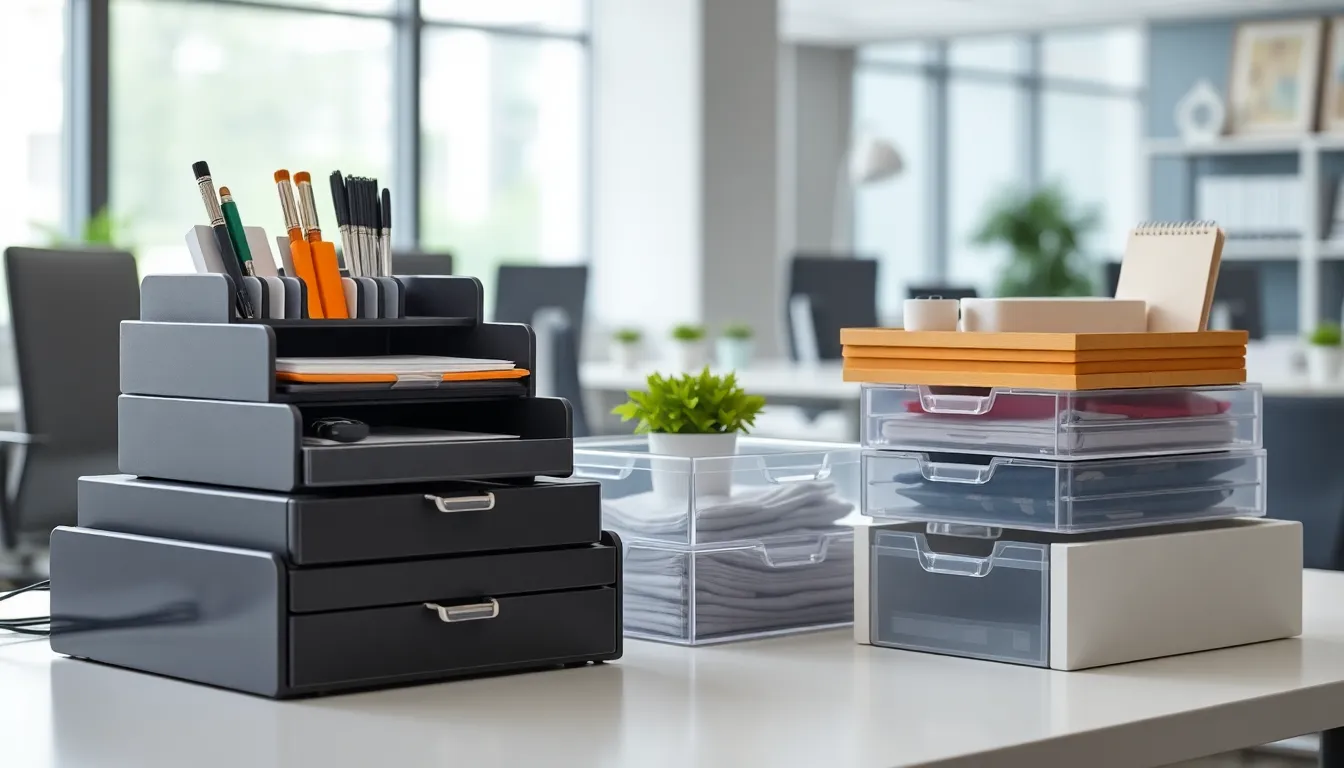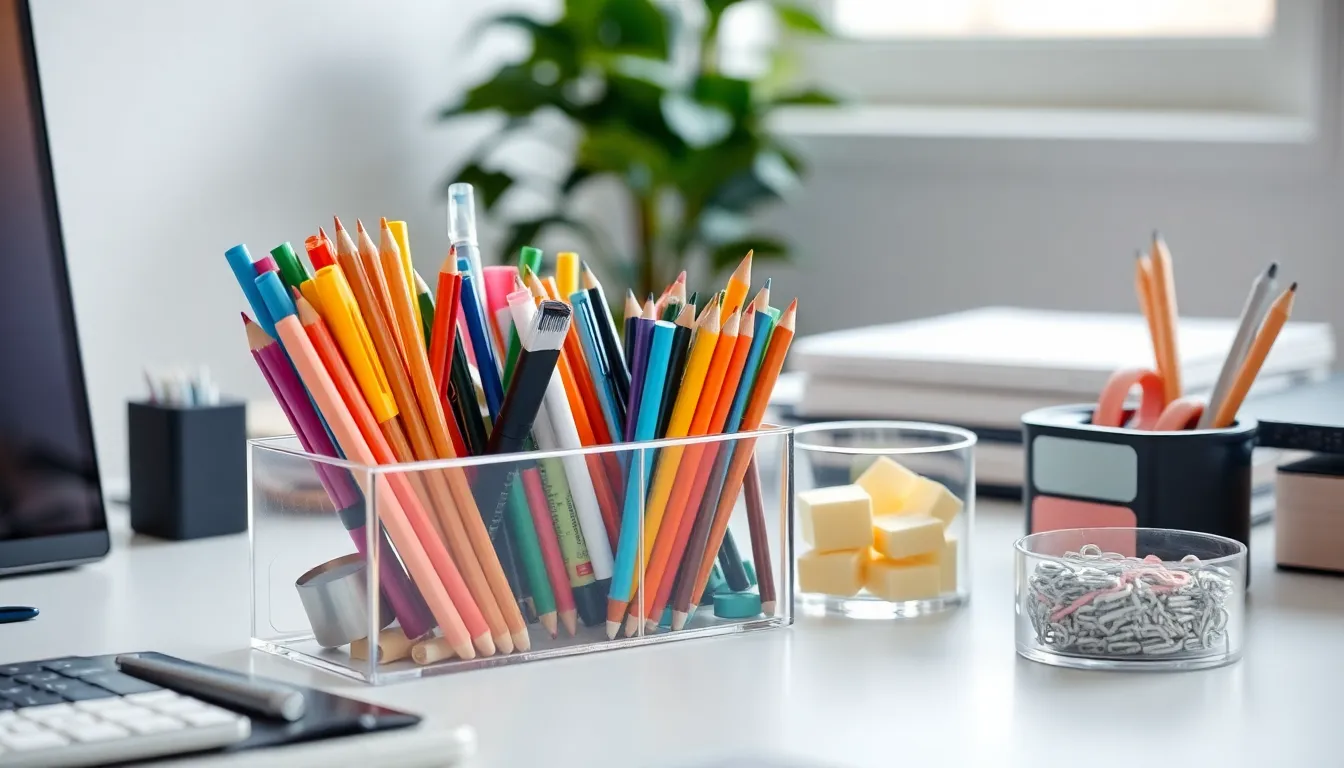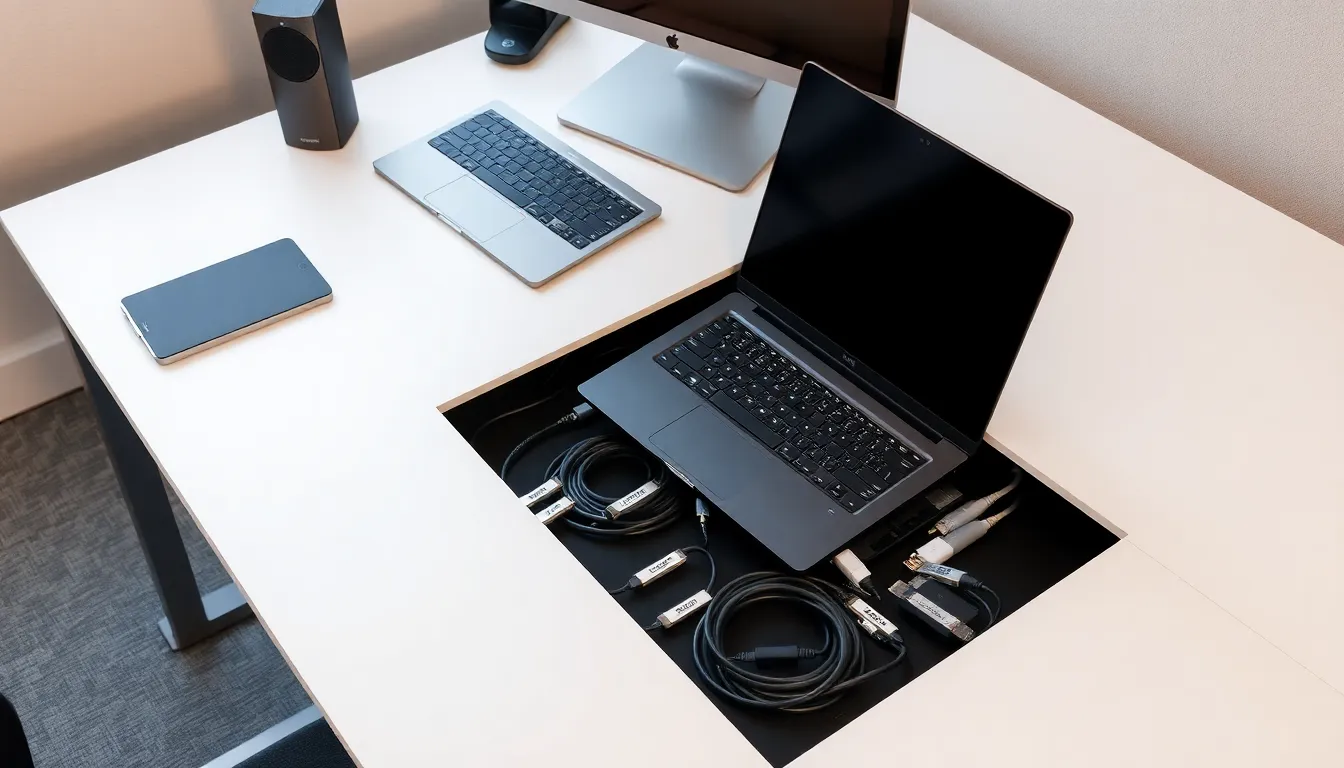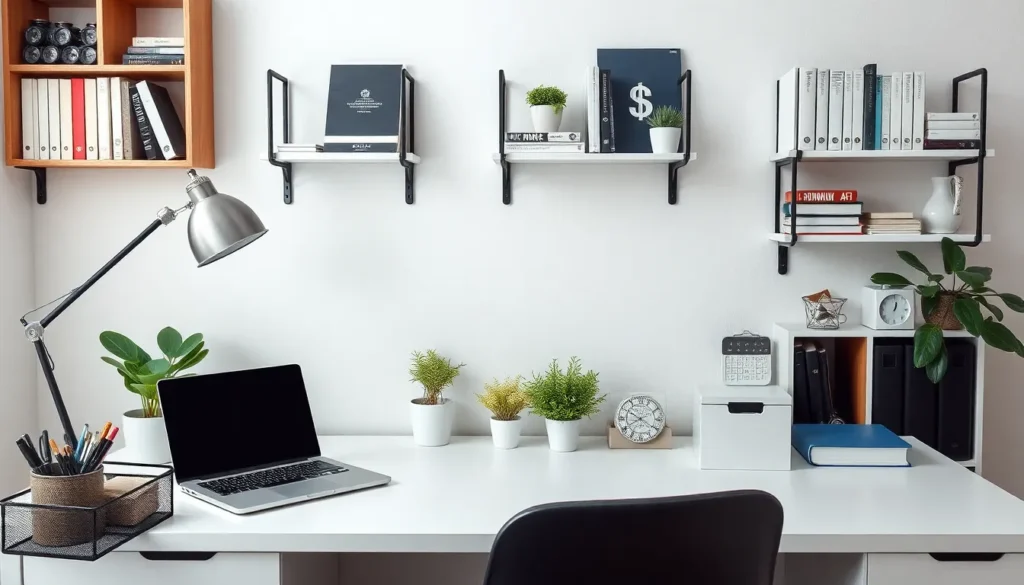We’ve all been there – staring at a cluttered desk wondering where our productivity went. A messy workspace doesn’t just look chaotic; it actively sabotages our focus and efficiency. When papers pile up, supplies disappear into the void, and cables tangle like jungle vines, even simple tasks become overwhelming.
The good news? Transforming your desk from disaster zone to productivity powerhouse is easier than you think. We’ve discovered that the right organization strategies can boost your efficiency by up to 40% while reducing stress levels dramatically. It’s not about having the fanciest organizers or the biggest budget – it’s about implementing smart systems that work with your natural habits.
Ready to reclaim your workspace and supercharge your productivity? We’ll share proven desk organization ideas that’ll turn your chaotic desktop into a streamlined command center where everything has its place and you can find what you need instantly.
Clear Your Desk Surface for Maximum Productivity
Clearing your desk surface creates the foundation for enhanced focus and workflow efficiency. We’ll explore three proven strategies that transform cluttered workspaces into productivity powerhouses.
Remove Unnecessary Items Daily
Daily decluttering prevents workspace chaos from accumulating over time. We recommend conducting a 5-minute sweep at the end of each workday to maintain optimal desk conditions.
Remove items that don’t serve your immediate work needs, such as old coffee cups, outdated paperwork, promotional materials, and personal items that distract from tasks. Sort through papers by keeping only documents you’ll reference within 24 hours on your surface.
Store reference materials in designated filing systems rather than leaving them scattered across your workspace. We’ve found that professionals who maintain daily clearing routines report 25% less time spent searching for essential items.
Establish a “one day rule” for temporary items like packages, mail, or borrowed supplies. Items that remain on your desk longer than one day should find permanent homes in drawers, shelves, or storage areas.
Carry out the One-Touch Rule
Handle each item only once to eliminate decision fatigue and improve workflow speed. We apply this principle by immediately deciding whether to file, act on, or discard items as they cross our desk surface.
Process incoming documents within 30 seconds of touching them. File important papers immediately, add action items to your task list, or recycle materials you won’t need again.
Digital applications of the one-touch rule include closing browser tabs after use and organizing downloads into proper folders. We’ve observed that workers who follow this system reduce their average task completion time by 20%.
Create action bins for items requiring exact responses. Label containers as “To Review,” “To File,” or “To Return” so you can quickly categorize materials without creating surface clutter.
Create Designated Zones
Assign exact desk areas for different work functions to maintain consistent organization patterns. We divide workspaces into three primary zones: active work area, reference zone, and supply station.
Position your active work area directly in front of your seating position for immediate access to current projects. Keep only essential tools like pens, notepads, and your computer within arm’s reach of this central zone.
Establish your reference zone on your desk’s right or left side for frequently accessed materials. Place items like calendars, contact lists, and project folders in this secondary area where they remain visible but don’t interfere with active tasks.
Design your supply station at the desk’s far edge or corner for storage of backup materials. Stock this zone with extra pens, sticky notes, paper clips, and other consumables that support your daily workflow without creating visual distractions.
Utilize Vertical Space with Smart Storage Solutions

Maximizing our desk space doesn’t mean expanding outward when we can build upward. Research shows that organized workspaces can increase productivity by up to 15%, making vertical storage answers essential for creating an efficient work environment.
Install Floating Shelves Above Your Desk
Floating shelves transform the wall space above our desks into valuable storage real estate. Installing these shelves directly above our work surface keeps frequently used books, files, and reference materials within arm’s reach while freeing up precious desk space below. We can store our most important documents on the lower shelf for easy access and place decorative items or less frequently used materials on higher shelves.
Strategic placement of floating shelves reduces unnecessary movement during our workday. Books we reference daily can sit at eye level, while project files stay organized and visible without creating desk clutter. This setup minimizes distractions by keeping our work surface clear while maintaining visual access to essential materials.
Add Pegboard Systems for Hanging Storage
Pegboard systems offer the ultimate flexibility for hanging storage that adapts to our changing needs. These versatile walls accommodate various hooks, baskets, and holders that we can rearrange as our work requirements evolve. Office supplies like scissors, staplers, and tape dispensers hang within easy reach, while cable management becomes effortless with specialized pegboard accessories.
Customization makes pegboard systems particularly valuable for our workspace organization. Small items that typically scatter across our desk surface find designated spots on hooks and in hanging containers. Tools we use frequently stay visible and accessible, supporting an ergonomic workflow that reduces strain and increases efficiency throughout our workday.
Use Wall-Mounted Organizers
Wall-mounted organizers create dedicated spaces for notes, reminders, and important documents without consuming desk space. Magnetic boards hold metal clips and containers for quick access to supplies, while cork boards display our project timelines, inspiration, and urgent reminders. These organizers keep our visual workspace clear while ensuring critical information remains prominently displayed.
Different organizer types serve exact functions in our vertical storage strategy. File holders mounted on walls store active projects and incoming documents, while small bins organize pens, paper clips, and other frequently used supplies. This approach reduces visual clutter on our desk surface while maintaining easy access to materials we need throughout our workday.
Invest in Multi-Functional Desk Accessories

Multi-functional desk accessories serve as the foundation for transforming cluttered workspaces into productivity powerhouses. These versatile answers maximize both space and efficiency while reducing the number of items needed on your desk.
Choose Desk Organizers with Multiple Compartments
Compartmentalized desk organizers offer designated spaces for different types of supplies, eliminating the guesswork when searching for exact items. We recommend selecting organizers with separate sections for pens, papers, and office materials to maintain easy accessibility throughout your workday.
Modern desk organizers feature adjustable dividers that adapt to your changing storage needs. Some models include built-in slots for smartphones and tablets, creating a centralized command center for all your essential tools. These organizers keep everything within arm’s reach while maintaining a clean, professional appearance.
The best compartmentalized organizers combine vertical and horizontal storage elements. Tiered designs provide multiple levels of organization without consuming additional desk real estate, making them ideal for compact workspaces.
Select Storage Boxes That Stack
Stackable storage boxes create vertical storage answers that keep less frequently used items organized yet accessible. We suggest choosing boxes with clear sides or label windows to quickly identify contents without opening each container.
Uniform sizing ensures stable stacking while maximizing storage capacity. Many stackable systems include interlocking features that prevent boxes from sliding or toppling, providing secure storage for important documents and supplies.
These storage answers work particularly well for seasonal office supplies, archived projects, and backup materials. By storing these items vertically, you free up valuable desk surface area for active work projects while maintaining quick access when needed.
Use Drawer Dividers for Small Items
Drawer dividers prevent small office supplies like paper clips, staples, and pushpins from creating chaotic jumbles in desk drawers. These organizational tools create designated spots for every small item, dramatically reducing the time spent searching for exact supplies.
Adjustable dividers offer flexibility to accommodate items of various sizes within the same drawer. We find that expandable divider systems work best as they can be customized to fit different drawer dimensions and supply collections.
Spring-loaded dividers maintain their position even when drawers are opened and closed frequently. This stability ensures that your organizational system remains intact throughout busy workdays, preventing the gradual migration of items that often leads to drawer chaos.
Create a Filing System That Actually Works

Building on our multi-functional storage approach, we need a document management system that eliminates the chaos of scattered papers and digital files.
Sort Documents by Frequency of Use
Organize documents based on access frequency to streamline your daily workflow and reduce time spent searching. Place your most frequently used documents in the top drawer or front section of your filing cabinet where they’re immediately accessible. Daily documents like project files, meeting notes, and active contracts should occupy prime real estate on your desk or in your primary filing area.
Store weekly documents in secondary locations such as lower drawers or nearby filing cabinets. Monthly documents can be placed in less accessible areas like high shelves or back sections of storage units. Archive documents you rarely access in storage boxes or digital backup systems to free up valuable workspace.
Create three distinct access zones for maximum efficiency. Your immediate zone should contain documents you touch daily, your secondary zone for weekly materials, and your archive zone for monthly or yearly references. This frequency based approach reduces retrieval time by up to 60% compared to alphabetical filing systems.
Label Everything Clearly
Use consistent labeling conventions across all filing systems to ensure quick identification and retrieval. Choose either all caps or sentence case for labels and stick with that format throughout your entire system. Color coding different categories enhances visual recognition and speeds up document location.
Apply the KISS principle (Keep It Simple, Stupid) when creating labels. Write labels that clearly describe contents without unnecessary words or complex abbreviations. Instead of “Q3 2025 Marketing Campaign Performance Analysis Reports,” use “Q3 2025 Marketing Reports.” This approach reduces cognitive load and improves filing accuracy.
Position labels consistently on the same location of every folder, container, and storage unit. Place labels on the front right corner of file folders and center them on storage boxes. Consistent positioning creates visual patterns that your brain recognizes instantly, reducing search time by an average of 30%.
Go Digital When Possible
Scan physical documents to create digital backups and reduce paper clutter on your desk surface. Use scanner apps on your smartphone for quick digitization of receipts, business cards, and meeting notes. High resolution scans ensure document readability while freeing up physical storage space.
Organize digital files using the same frequency based system as physical documents. Create folder structures that mirror your physical filing system for seamless transitions between digital and paper workflows. Name digital files with dates and keywords to improve searchability through your computer’s search function.
Carry out cloud storage answers for enhanced accessibility and disaster protection. Services like Google Drive, Dropbox, or OneDrive allow document access from any device while providing automatic backup functionality. This digital approach eliminates the risk of losing important documents due to physical damage or misplacement.
Designate Specific Homes for Office Supplies

Assigning dedicated locations for every office supply creates the foundation for lasting workspace organization. When each item has its own designated spot, we eliminate the guesswork and frustration that comes with searching for misplaced materials.
Group Similar Items Together
Clustering related supplies transforms scattered chaos into organized efficiency. Pens live alongside pencils and markers in one container, while paper clips join rubber bands and binder clips in another designated space. Sticky notes find their home next to index tabs and labels, creating logical groupings that match our natural workflow patterns.
Office Supply Categories to Group:
| Category | Items | Storage Location |
|---|---|---|
| Writing Tools | Pens, pencils, markers, highlighters | Desktop organizer compartments |
| Paper Fasteners | Clips, staples, rubber bands, binder clips | Small drawer dividers |
| Adhesives | Tape, glue sticks, sticky notes, labels | Shallow desk drawer |
| Reference Materials | Rulers, calculators, correction fluid | Secondary desk zone |
Use Clear Containers for Easy Identification
Transparent storage eliminates the mystery of hidden contents and speeds up our daily routines. Glass jars work perfectly for storing smaller items like thumbtacks and paper clips, while clear acrylic organizers showcase writing instruments without concealing their colors or quantities. Stackable clear bins allow us to see exactly what’s available at a peek, reducing the time spent opening multiple containers during busy workdays.
Benefits of transparent storage include immediate visual inventory checks and faster item retrieval. We’ll never again wonder whether we have enough supplies for an important project, since everything remains visible and accountable.
Keep Frequently Used Items Within Arm’s Reach
Positioning daily essentials within easy grasp enhances productivity and maintains our workflow momentum. Pens and highlighters earn prime real estate in desktop organizers, while staplers and tape dispensers claim spots on our immediate work surface. Less frequently used supplies like hole punchers and label makers can occupy secondary storage areas or desk drawers.
Studies show that organizing frequently used items within arm’s reach can improve productivity by reducing interruptions and maintaining focus on important tasks. Creating this “golden triangle” of essential supplies means we’ll spend more time accomplishing goals and less time hunting for basic tools.
- Daily use: Desktop organizer or pen holder
- Weekly use: First desk drawer or nearby shelf
- Monthly use: Secondary drawer or storage cabinet
- Occasional use: Filing cabinet or supply closet
Manage Your Cable Chaos Effectively

Tangled cables and charging cords create visual clutter that can undermine even the most organized workspace. We’ll explore three proven cable management strategies that keep your desk looking professional while maintaining easy access to all your devices.
Use Cable Management Trays
Cable management trays transform scattered wires into organized channels that route beneath or alongside your workspace. These versatile answers can be mounted directly on your desk surface or attached underneath to keep cables completely out of sight.
Position trays strategically near your computer setup to capture power cords, USB cables, and charging wires in one designated area. Most cable management trays feature multiple compartments that separate different types of cords, preventing tangling while maintaining easy access for daily use.
Choose trays with adjustable widths to accommodate various cable thicknesses, from thin phone chargers to thick monitor cables. This flexibility ensures your cable management system grows with your technology needs without requiring complete reorganization.
Carry out Under-Desk Cable Organizers
Under-desk cable organizers provide invisible storage answers that completely eliminate desktop cable clutter while maintaining full functionality. These systems mount beneath your work surface, creating dedicated pathways for power strips, adapters, and excess cable length.
Install mesh cable trays or solid mounting brackets that support the weight of power strips and surge protectors underneath your desk. This positioning keeps electrical components off the floor while providing easy access for plugging and unplugging devices.
Route cables through designated entry and exit points to create clean lines that flow naturally from your devices to their power sources. Strategic cable routing prevents accidentally unplugging important connections while keeping your workspace visually clean and professionally organized.
Label All Cords and Cables
Labeling transforms cable identification from guesswork into instant recognition, reducing troubleshooting time and preventing accidental disconnections. We recommend using clear, durable labels that withstand frequent handling and remain legible over time.
Create consistent labeling systems that identify both the device and cable type, such as “Monitor HDMI” or “Phone Charger USB-C.” This specificity helps distinguish between similar looking cables and prevents confusion when making connections or performing maintenance.
Apply labels near cable connectors where they’re easily visible without requiring you to trace wires back to their sources. Consider using different colored labels to create visual categories, such as blue for computer peripherals and red for power cables, making identification even faster during busy workdays.
Establish Daily and Weekly Maintenance Routines

Maintaining our organized workspace requires consistent effort through structured routines. These essential habits prevent clutter from accumulating and ensure our productivity enhancements remain permanent.
End Each Day with a Clean Desk
Ending each workday with a clean desk creates the foundation for tomorrow’s success. We recommend spending just 5 minutes before leaving to restore our workspace to its organized state. Remove any papers that don’t belong in designated zones and return supplies to their exact homes.
Clear our desktop of coffee cups, snack wrappers, and personal items that accumulated throughout the day. This simple routine eliminates the overwhelming feeling of starting work with yesterday’s mess. Return reference materials to their proper filing locations and shut down equipment properly to maintain our organized cable management system.
File any documents that landed in our active work zone during the day but belong in secondary or archive areas. This prevents paper buildup that can quickly transform our streamlined workspace back into chaos. Wipe down surfaces to remove dust and fingerprints that can make even organized areas appear cluttered.
Schedule Weekly Deep Organization Sessions
Schedule weekly deep organization sessions every Friday afternoon or Monday morning to maintain our workspace’s peak efficiency. We suggest dedicating 30 minutes to thoroughly assess and refresh our entire desk organization system. During these sessions, we clean electronics, dust shelves, and reorganize supply containers that may have become disorganized.
Review our filing system’s effectiveness by checking whether documents are properly sorted by frequency of use. Adjust our golden triangle of essential supplies if we’ve noticed reaching for different items more frequently. Empty trash bins, replace worn labels, and ensure our cable management systems remain secure and functional.
Deep clean our vertical storage answers including floating shelves and wall mounted organizers. Wipe down surfaces, reorganize stackable storage boxes, and verify that our compartmentalized desk organizers maintain their optimal configuration. These weekly sessions prevent small organization issues from becoming major productivity obstacles.
Review and Purge Items Monthly
Review and purge items monthly to prevent accumulation of unnecessary supplies and documents. We recommend conducting this comprehensive review on the first Friday of each month when we can dedicate focused time to evaluation. Remove expired supplies, outdated reference materials, and broken accessories that no longer serve our productivity goals.
Assess our storage containers and drawer dividers to identify items we haven’t used in the past 30 days. These items should move to archive storage or be eliminated entirely to free up prime real estate for frequently used supplies. Update our labeling system to reflect any changes in our workflow patterns or supply needs.
Evaluate our workspace zones for continued effectiveness by tracking which areas we use most frequently. Reorganize our immediate, secondary, and archive access zones based on actual usage patterns rather than initial assumptions. This monthly review ensures our desk organization system evolves with our changing work requirements and maintains its 40% productivity enhancement potential.
Conclusion
We’ve covered the essential strategies to transform your cluttered workspace into a productivity powerhouse. By implementing these desk organization ideas consistently you’ll experience the 40% productivity boost that comes with a well-organized environment.
The key to success lies in maintaining these systems daily. Remember that organization isn’t a one-time project—it’s an ongoing commitment that pays dividends through reduced stress and improved focus.
Your organized desk will become the foundation for better work habits and enhanced professional success. Start with one strategy today and gradually build your organizational system over time.
Take action now and watch as your newly organized workspace becomes a catalyst for achieving your professional goals.
Frequently Asked Questions
How much can an organized workspace improve productivity?
A well-organized workspace can enhance productivity by up to 40% while significantly reducing stress levels. By implementing effective desk organization strategies, you can streamline your workflow, reduce time spent searching for items, and maintain better focus on important tasks throughout your workday.
What is the one-touch rule and how does it work?
The one-touch rule means handling each item only once when it crosses your desk. Instead of moving papers around multiple times, you immediately decide whether to act on it, file it, or discard it. This approach reduces decision fatigue and improves workflow speed by eliminating unnecessary handling.
How should I create designated zones on my desk?
Establish three main zones: an active work area for current projects, a reference zone for frequently accessed materials, and a supply station for tools and accessories. Keep each zone clearly defined and ensure items are returned to their designated areas after use to maintain organization and efficiency.
What are the best cable management solutions for a cluttered desk?
Use cable management trays mounted under your desk to organize cords, employ under-desk cable organizers to eliminate desktop clutter, and label all cables for easy identification. These solutions create clean lines, prevent accidental disconnections, and reduce troubleshooting time when managing your workspace connections.
How often should I declutter my workspace?
Perform daily 5-minute decluttering sessions at the end of each workday to maintain order. Schedule weekly deep organization sessions for thorough cleaning and reorganizing, plus conduct monthly reviews to purge unnecessary items and update your organization system based on actual usage patterns.
What filing system works best for desk organization?
Create three access zones based on frequency of use: immediate zone for daily documents within arm’s reach, secondary zone for weekly materials, and archive zone for less frequently accessed files. This system can reduce document retrieval time by up to 60% while maintaining easy access to important materials.
How can I maximize vertical space on my desk?
Install floating shelves, pegboard systems, and wall-mounted organizers to utilize vertical space effectively. Use stackable storage boxes for less frequently used items and consider multi-functional desk accessories that provide storage while serving other purposes, keeping your desktop surface clear and organized.
What’s the golden triangle concept for desk organization?
The golden triangle refers to positioning your most essential daily-use items within arm’s reach of your primary work position. This includes frequently used supplies like pens, notepads, and phone, creating an efficient workflow zone that minimizes movement and maximizes productivity during work tasks.







